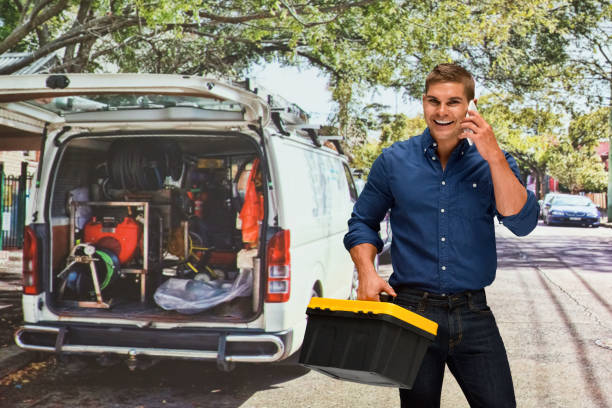Drain blockages can strike at the most inconvenient times, leaving you with backed-up sinks, unpleasant odours, or worse. While many homeowners reach for a plunger or chemical cleaner as their first line of defence, sometimes these DIY solutions simply don’t cut it. If you’re facing persistent drainage issues, you might be wondering whether to hire jetter suppliers in Melbourne or tackle the problem yourself. This guide helps homeowners, property managers, and small business owners make that crucial decision.
Key Takeaways
- Multiple fixture backups or slow drains that resist DIY methods indicate a need for professional jetting.
- DIY jetting carries risks including pipe damage, personal injury, and ineffective treatment of complex blockages.
- Professional jetters offer diagnostic inspection, specialised equipment, and proper waste disposal that DIY methods can’t match.
- Regular maintenance and safe disposal habits can reduce the need for emergency jetting services.
- Always choose licensed, insured jetting professionals when facing serious drain issues.
Key Signs You Should Call a Professional Jetter Service
Repeated or Multiple Fixture Backups
When multiple drains in your home start backing up simultaneously, or if you notice a pattern of recurring blockages in toilets, sinks, showers, or external drains, this typically signals a main line blockage beyond the reach of standard DIY tools. Such systemic issues rarely resolve themselves and usually worsen over time.
Slow Drains That Don’t Respond to Standard DIY Methods
If you’ve tried plunging, drain snaking, and enzyme cleaners without success, your blockage likely requires the higher pressure and specialised nozzles that only professional jetting equipment can provide. Persistent slow drainage suggests compacted debris or obstacles that hand tools simply cannot dislodge.
Foul Odours Coming From Drains or Yard
Persistent sewage smells indoors or in your yard often indicate trapped waste material or a breach in your sewer line. These issues pose health risks and rarely resolve with DIY treatments. Professional jetting can flush out trapped material and help identify any pipe damage causing the smell.
Water Pooling or Sewage Surfacing on Property
When wastewater or sewage begins to pool in your yard or bubble up through drains, you’re facing an emergency situation. This indicates a severe blockage or pipe damage that requires immediate professional attention to prevent property damage and health hazards.
“The moment you spot sewage backing up or pooling in your yard, it’s time to call professionals. These situations can quickly escalate from inconvenient to hazardous for your family and property.” – Melbourne Jetter Centre
Visible or Suspected Tree Root Intrusion
Tree roots naturally seek water sources, making sewer lines an attractive target. Signs include gurgling toilets, recurring blockages, and sinkholes in your yard. Root intrusions require specialised cutting nozzles and high-pressure water that DIY equipment simply cannot deliver.
Age or Material of Existing Pipes
Older homes with clay, cast-iron, or Orangeburg pipes require special care. DIY attempts with aggressive tools or chemicals can crack brittle pipes or damage corroded joints, turning a simple blockage into an expensive replacement job.
Risks and Limitations of DIY High-Pressure Jetting
Potential for Pipe Damage
Consumer-grade jetters lack the pressure control and specialised nozzles professionals use. Incorrect pressure or angle can crack pipes, damage joints, or push blockages deeper into your system, worsening the original problem and potentially causing water damage to your property.
Personal Safety Hazards
High-pressure water can cause serious injuries, including skin lacerations and eye damage. Additionally, sewage backups contain harmful bacteria and pathogens. Professional jetters wear proper protective equipment and follow safety protocols that most homeowners lack.
Ineffective Treatment of Complex Blockages
DIY equipment rarely handles stubborn blockages like grease buildup, mineral scale, tree roots, or collapsed pipe sections. These require industrial-grade equipment with specific nozzles and pressures that professionals have trained extensively to use.
Insurance and Liability Issues
Many home insurance policies won’t cover damage resulting from DIY plumbing repairs gone wrong. Additionally, some warranties become void if non-professionals attempt certain repairs, leaving you financially responsible for any resulting damage.
What Professional Jetter Services Do
Initial Diagnostic Inspection
Professional services begin with CCTV drain camera inspection to identify the exact location, nature, and severity of the blockage. This precision approach prevents unnecessary work and ensures the correct solution is applied from the start.
High-Pressure Water Jetting Operation
Professional jetters operate equipment capable of 4,000-5,000 PSI with various specialised nozzles designed for different blockages. These systems can clear everything from grease buildup to tree roots while protecting your pipes from damage.
Additional Repair Options
Beyond clearing blockages, professionals can offer root cutting, hydro-excavation for accessing buried pipes, pipe relining for damaged sections, and replacement recommendations when necessary. This comprehensive approach addresses both immediate and underlying issues.
Waste Capture and Environmental Disposal
Professional services properly capture and dispose of waste material according to local regulations. This prevents environmental contamination and health hazards that can occur when sewage is improperly handled during DIY attempts.
Cost, Timing and Value Comparison
Typical Cost Ranges in Australia
Professional jetting services typically range from $250-$500 for standard residential jobs during business hours, with emergency after-hours service costing $350-$700. Regional areas may see higher prices due to travel requirements and equipment availability.
Factors That Increase Cost
Difficult access points, required CCTV inspection, root removal, and additional repairs all affect final pricing. However, these factors also reflect a more thorough solution to your drainage problems than temporary DIY fixes can provide.
Long-Term Value vs One-Off DIY Fixes
While DIY solutions appear cheaper initially, professional jetting often provides better long-term value by thoroughly clearing lines and identifying potential future issues. This preventative approach reduces repeat blockages and prevents costly emergency situations.
How to Choose a Reliable Jetter Service
Licensing, Insurance and Local Regulations
Always verify that your jetting service holds appropriate plumbing licenses and carries public liability insurance. This protects you from liability if accidents occur during service and ensures the work meets local code requirements.
Experience and References
Ask how long the company has been performing jetting services specifically, not just general plumbing. Request references or check online reviews focusing on their drain clearing services. Avoid companies unwilling to provide this information.
Equipment Capability and Safety Practices
Quality services use professional-grade equipment with appropriate pressure ratings (4,000+ PSI) and various nozzle types. They should follow clear safety protocols including property protection measures and proper personal protective equipment.
Environmental and Waste-Handling Practices
Reputable companies follow state and local waste disposal regulations. Ask about their waste capture and disposal methods to ensure environmentally responsible service that won’t create contamination issues on your property.
Preparing for a Professional Visit
How to Prepare the Property
Clear access to all drain points, move vehicles from driveways if external drains need accessing, and protect nearby surfaces or belongings that could be affected by water. Point out any known pipe locations or previous drainage work to the technician.
Typical On-Site Steps Technicians Take
Expect an initial inspection, equipment setup, jetting operation, verification camera pass to confirm clearance, and thorough cleanup. Technicians should explain what they find and any recommendations for future maintenance.
Post-Service Documentation and Guarantees
Quality services provide detailed work reports, receipts, warranty information for any repairs, and recommended follow-up schedule. Keep these records for insurance purposes and to track your property’s maintenance history.
Preventive Maintenance and Safe DIY Alternatives
Routine Maintenance Schedule Recommendations
Residential properties typically benefit from professional jetting every 18-24 months. Commercial kitchens may need quarterly service, while rental properties should be checked between tenants or annually to prevent unexpected issues.
Safe DIY Habits to Reduce Blockages
Prevent blockages by avoiding disposing of fats, oils, coffee grounds, and food waste down drains. Use drain catchers for hair and never flush wet wipes, sanitary products, or paper towels, even if labelled “flushable.”
Low-Risk DIY Options Before Calling a Pro
For minor clogs, try manual plunging, enzyme-based biological cleaners that break down organic matter, or hand augers for accessible clogs. Stop DIY attempts if you encounter resistance, multiple fixture backups, or if initial efforts produce no improvement.
Conclusion
When facing persistent drain issues, recurring blockages, multiple fixture backups, or signs of serious pipe problems, professional jetting services offer the expertise, equipment, and safety measures that DIY methods simply can’t match. While minor clogs might respond to home remedies, significant drainage problems require professional attention to prevent property damage and health hazards. Melbourne Jetter Centre recommends contacting a licensed, insured jetting service at the first sign of serious drain issues rather than risking property damage with inadequate DIY solutions.






